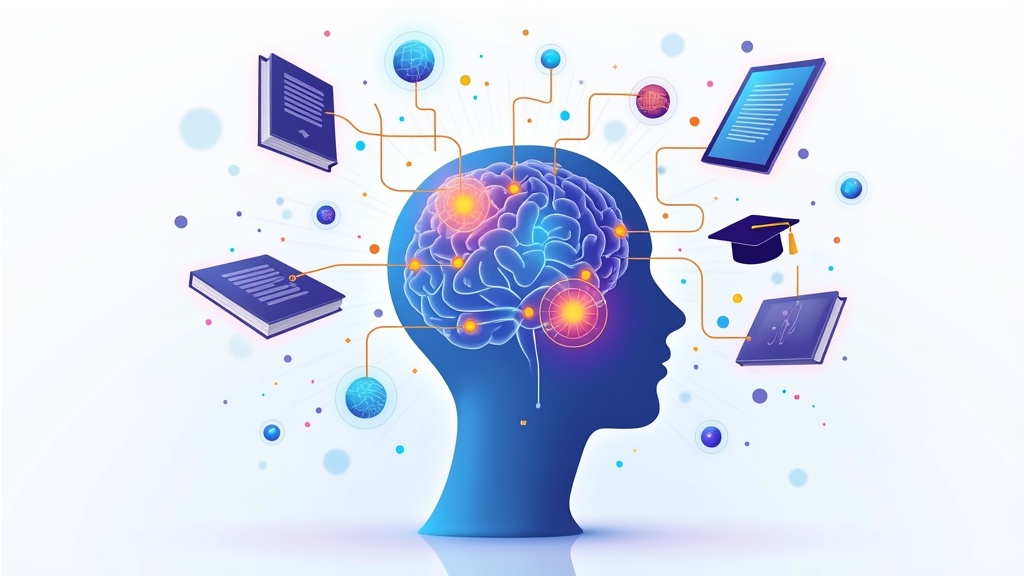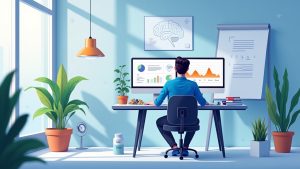Understanding how your brain learns
Have you ever thought that understanding how your brain works could be the key to completely transforming your university experience? Neuroscience reveals that learning is not a magical process, but rather a series of biological mechanisms that we can intentionally optimize. When you know these principles, you stop studying by trial and error and start using strategies proven by science.
Your brain has around 86 billion neurons that communicate through synapses, forming complex networks that represent each piece of knowledge you acquire. Neuroplasticity - the brain's ability to reorganize itself and form new connections - is the physiological basis of learning. Every time you review content or practice a skill, you are strengthening these neural pathways, making information retrieval more efficient in the future.
Imagine that creating lasting memories is like blazing a trail in a closed forest: the more you walk the same path, the more defined and accessible it becomes. This process of neural consolidation explains why spaced repetition works so well - it tricks the brain into prioritizing information that periodically reappears as important. How about starting to observe which methods make your brain respond better?
The myth of learning styles and the truth about multimodality
For years, many have believed that each person has a predominant learning style - visual, auditory or kinesthetic. Contemporary neuroscience shows that this division is a simplistic myth that can limit your potential. Your brain learns best when multiple senses are involved simultaneouslycreating richer, more interconnected neural networks.
Neuroimaging research shows that information presented in a multimodal way activates distinct but complementary brain regions. When you study history not only by reading, but also by watching documentaries, listening to podcasts and discussing with colleagues, you are creating a multidimensional mental map. This sensory redundancy provides more "hooks" to retrieve information when needed, especially under pressure of exams.
Try turning that dense constitutional law content into a colorful visual diagram while recording an audio explaining the concepts in your own words. The combination of verbal elaboration and visual organization engages both the left and right hemispherescreating a more complete and memorable learning experience. Isn't it fascinating how we can hack our own cognitive system?
The science behind memory and forgetting
Have you ever wondered why you remember the lyrics to a song from your childhood perfectly, but forget mathematical formulas you studied last week? Neuroscience explains that memory is not a static file, but a dynamic process influenced by emotional, contextual and biological factors. The Ebbinghaus forgetting curve shows that we lose approximately 56% of information in an hour if we don't review itand reached 79% after 31 days.
Two neurological processes are crucial: the consolidation (transformation of memories from short to long term) and the recovery (access to stored information). The practice of active recall - trying to remember without consulting the material - significantly strengthens both processes. Instead of passively re-reading your notes, test yourself regularly; this momentary difficulty generates longer-lasting learning.
The technique of spacing revisions takes advantage of the reconsolidation of memoryEach time we retrieve information, it becomes temporarily malleable before being stored again in a strengthened form. Tools like Anki or Quizlet use algorithms based on this principle to optimize your revision schedule. Anki - Spaced Repetition Why not try creating your first flashcards today?
Neurochemistry of learning: how dopamine, noradrenaline and cortisol influence your performance
Your brain has a sophisticated neurochemical system that regulates attention, motivation and the consolidation of memories. A dopamineThe reward system, released when we experience novelty or receive rewards, strengthens the neural connections of learning and creates positive expectations for future study sessions. Small achievements - such as completing a module or solving a difficult problem - intentionally activate this reward system.
The noradrenaline modulates your alertness and attention, and is crucial for filtering out relevant stimuli during study. Moderate levels improve focus, while too much can cause harmful anxiety. O cortisolStress, in high and prolonged doses, damages neurons in the hippocampus - a region essential for the formation of new memories. This explains why studying under extreme stress yields so little.

Simple strategies such as setting clear goals and celebrating small progress stimulate dopamine. Breathing techniques and short breaks regulate noradrenaline and cortisol. Insight Timer - Guided Meditations How about setting alarms every 45 minutes to breathe deeply for two minutes? Your brain will thank you with better performance.
Neuroscientific techniques applied to university study
Shall we turn theory into practice? A recovery practice is one of the most proven strategies: set aside 30% of time to absorb content and 70% to try to retrieve it without consulting. This could mean closing the book and writing down everything you remember about the subject, or explaining the concept to a colleague (or even your mirror). The difficulty felt during this retrieval is exactly what strengthens neural connections.
A interleaving of materials seems counter-intuitive but is extremely effective. Instead of blocking out six hours for a single subject, alternate between two or three different areas in 50-90 minute sessions. This "cognitive discomfort" forces your brain to discriminate concepts better and create more flexible connections. You will notice that you return to each subject with renewed mental freshness.
Finally, never underestimate the sleep as an active cognitive process. During deep sleep, your brain reactivates, reorganizes and consolidates the day's memories, transferring them from the hippocampus to the prefrontal cortex. Sleeping after studying is like pressing "save" on a document - without it, much of the effort is simply lost. National Sleep Foundation How about reprogramming your schedule to prioritize these 7-8 essential hours?
Beyond techniques: optimizing environment, emotions and mindset
The physical and emotional context in which you study profoundly modulates learning efficiency. Environments with natural lighting, mild temperatures and minimalist organization reduce the cognitive load dedicated to processing distractions. Studies show that even the simple visualization of windows with nature can improve concentration and retention of information by 15%.
Emotions are gatekeepers of memory: emotionally charged content - whether positive or negative - is remembered much more easily. Associating positive emotions with studying through inspiring music, rewards and encouraging self-talk creates more robust mnemonic landmarks. Turn difficult subjects into exciting challenges而不是 sources of anxiety.
Your mindset about intelligence as a fixed or malleable quality literally alters your neurobiology. People with a growth mindset show greater activation in regions related to error and correctionprocessing mistakes as learning opportunities而不是 personal failures. Mindset Works When you get a question wrong, try saying "I haven't mastered that yet"而不是 "I'm never going to learn it". The neural difference is measurable.
Implementing sustainable change: neuroscience applied to routine
Turning knowledge into action requires a gradual approach and self-compassion. Start by implementing a single new technique a week, monitoring its effects through a learning diary. The author's metacognitive monitoring - reflecting on what worked and what didn't - develops neural networks of self-regulation that will be useful throughout your academic and professional life.
Establish pre-study rituals that signal to your brain that it's time to go into focus mode. It could be preparing a cup of tea, organizing the desk, or three minutes of conscious breathing. These rituals activate conditioned neural patterns that facilitate the transition to a state of deep concentrationThis reduces the time it takes to "pick up the pace".
Remember that your brain is unique - what works brilliantly for your colleague may not be ideal for you. Experiment, adjust, and above all: observe. Neuroscience offers principles, but the creative application of these principles is your personal journey of cognitive self-knowledge. UNC Learning Center How about choosing a strategy from this list to try out today? Your neuroplastic potential is waiting to be unlocked.



